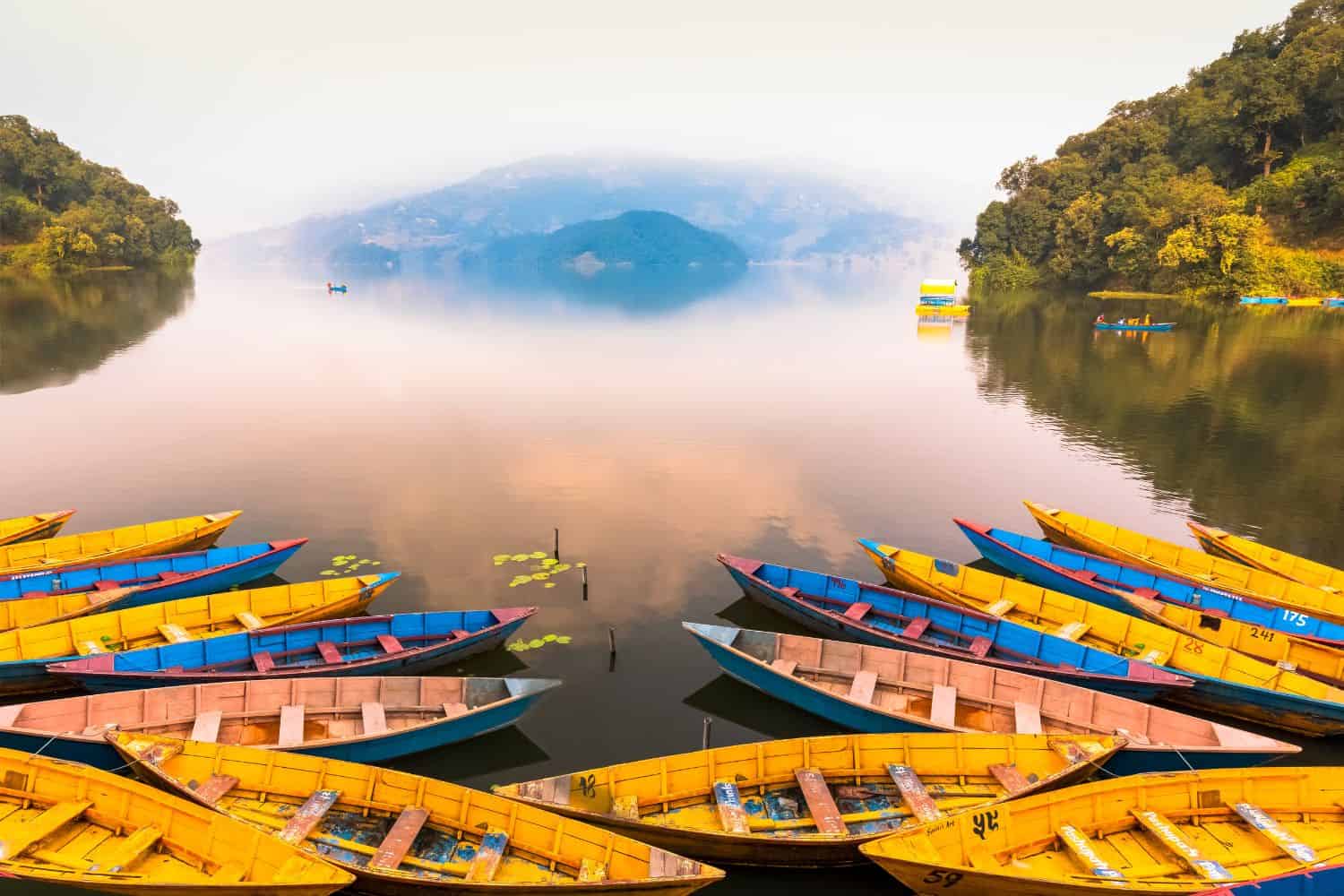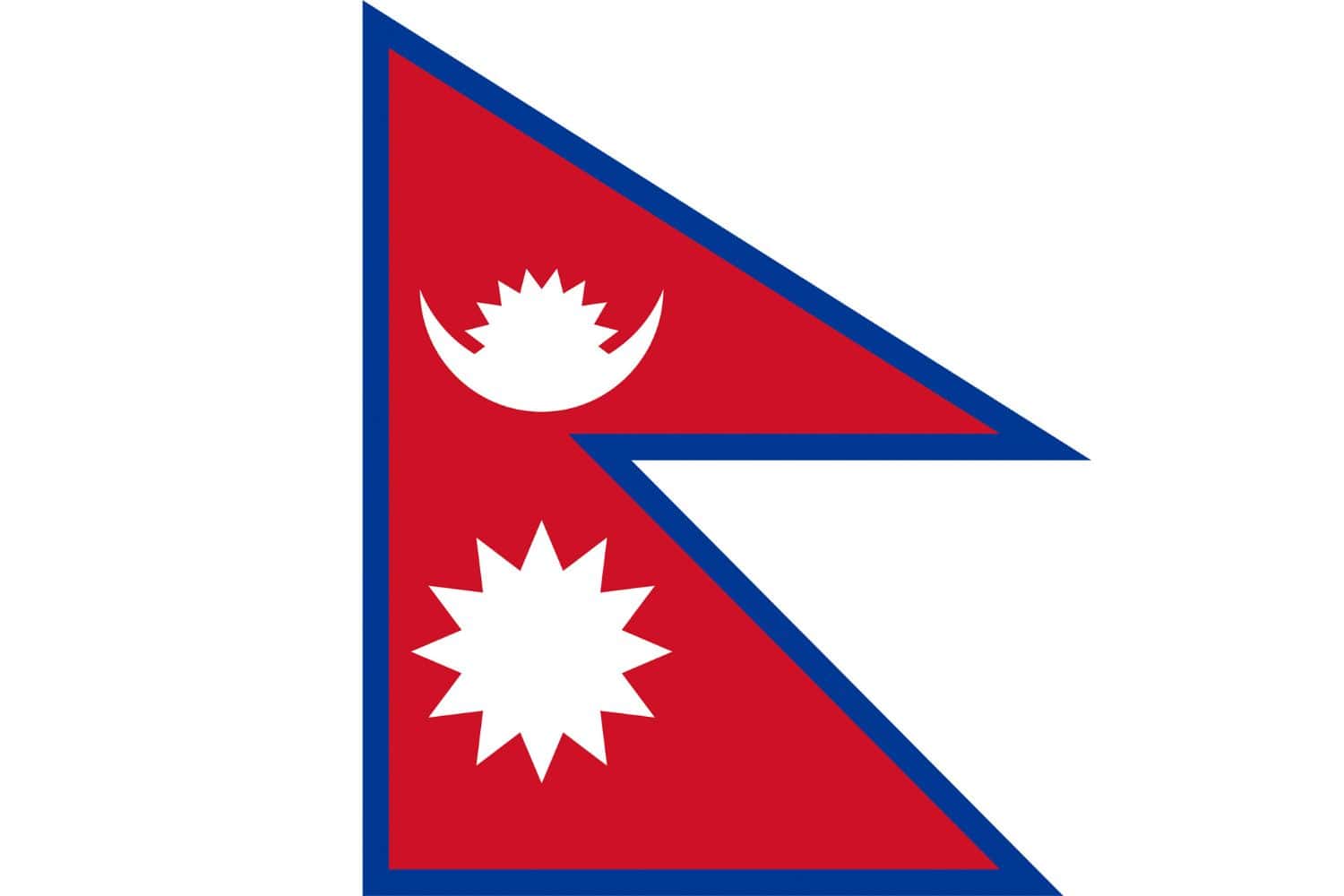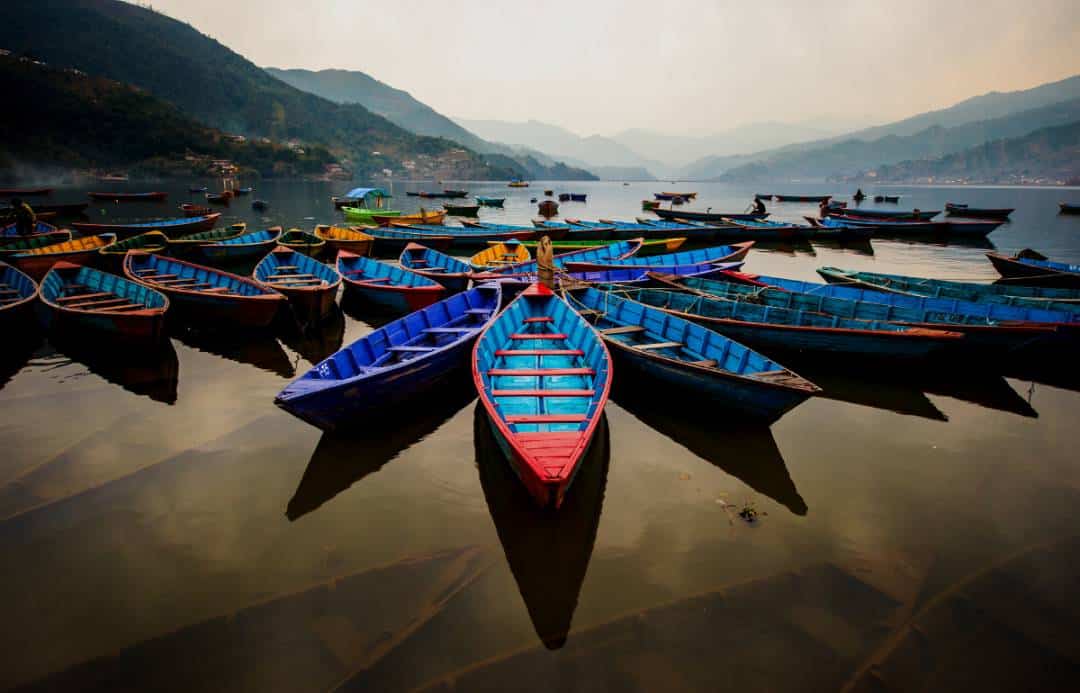Table of Contents
The geography of Nepal is a mesmerizing fusion of varied terrains and historical importance. Located in South Asia, this nation’s geographic position has been instrumental in molding its history and cultural legacy.
Tucked between the vast plains of the Indian subcontinent and the towering peaks of the Himalayas, Nepal geography invites daring travelers with its lush valleys, impressive mountain ranges, and spiritual sites. From ascending the awe-inspiring heights of Everest to delving into the cultural mosaic of Kathmandu, Nepal’s varied terrains and deep history provide an unparalleled journey for adventurous tourists seeking a profound and enriching experience.
The physical geography of Nepal showcases a series of natural wonders. From the renowned peaks of the Annapurna range, reflecting the nation’s rich mountainous heritage, to the diverse habitats that range from subtropical jungles to alpine meadows, Nepal stands as a tribute to nature’s magnificence.
Top Geographic Features of Nepal
- Himalayan Mountain Range: The mighty Himalayas stretch across the northern part of Nepal, dictating its topography and climate. This range includes Mount Everest, the highest peak in the world.
- Gandaki River: A significant river in Nepal, the Gandaki meanders through the central region, offering vital water resources for agriculture and hydroelectricity.
- Terai Plains: These expansive lowlands lie in the southern part of Nepal and are essential for the nation’s agricultural activities, especially rice and sugarcane cultivation.
- Mustang Plateau: Located in the northern part of Nepal, this semi-arid region is recognized for its ancient Tibetan culture, cliffs, and barren landscapes.
- Rara Lake: Nestled in the remote northwestern part of Nepal, this pristine lake is the largest in the country and a major tourist attraction.
- Chitwan Valley: This region in southern Nepal is renowned for its subtropical jungles, fertile farmlands, and the famous Chitwan National Park, home to the endangered Bengal tiger and one-horned rhinoceros.
- Koshi River: A significant river system in eastern Nepal, the Koshi River is crucial for irrigation and supports diverse ecosystems.
- Sagarmatha National Park: Located in the Himalayas, this park encompasses Mount Everest and is home to a diverse range of flora and fauna, including the elusive snow leopard.
- Lumbini: Located in the Terai plains, Lumbini is the birthplace of Lord Buddha and a UNESCO World Heritage site, attracting thousands of pilgrims and tourists annually.
- Annapurna Massif: A major mountain range in central Nepal, the Annapurna region is popular for treks and boasts diverse landscapes from subtropical forests to alpine terrains.
These geographic features play a pivotal role in shaping Nepal’s landscape, climate, and cultural history, making them integral in defining the country’s geography.
Nepal Geography
Exploring the Nepal National Geographic canvas reveals an awe-inspiring array of geographic features. From the towering Himalayan mountains to the fertile Terai plains and the culturally rich Kathmandu Valley, the country offers a mesmerizing mosaic of natural wonders.
- Mountain Ranges – The Crown of Diversity: Similar to documentaries that frequently feature imposing mountain ranges, Nepal is home to the iconic Himalayas. These majestic peaks not only contribute to the country’s scenic grandeur but also harbor unique biodiversity and have carved its cultural heritage.
- Lakes – A Kaleidoscope of Colors: Nepal’s Rara National Park, with its serene Rara Lake, resembles the picturesque sceneries often captured in photographs. These pristine lakes, nestled amidst forests and mountains, reflect the nation’s geological diversity.
- Terai – Fertile Plains of Life: Just as documentaries shed light on vast landscapes, Nepal’s Terai region exhibits fertile plains that house a diverse range of wildlife. This region narrates tales of Tharu traditions and the country’s agricultural significance.
- Historical Sites – Unveiling the Past: Nepal’s historical sites, like the ruins of Lumbini, remind us of journeys that unearth ancient civilizations. These remnants stand as a testament to the nation’s rich Buddhist and Hindu heritage.
- Ethnic Diversity – A Cultural Melting Pot: Echoing National Geographic’s emphasis on varied cultures, Nepal is a fusion of ethnic groups, including Newars, Sherpas, and Tamangs. Each community brings forward unique traditions, languages, and customs, contributing to a lively cultural tableau.
- Wildlife – A Sanctuary for Nature: Nepal’s protected areas, such as the Chitwan National Park, emulate the dedication to wildlife conservation. These zones act as essential habitats for a plethora of species, conserving biodiversity in a diverse setting.
- Geological Marvels – A Natural Showcase: The country’s geological wonders, like the Annapurna Circuit, highlight Nepal’s innate beauty amidst the towering Himalayas. Such landscapes display the potent forces of nature in action.
- Remote Exploration – Uncharted Territories: The remote and secluded areas of Mustang invite adventurers, reminiscent of journeys into untrodden domains. This vast realm provides insights into untouched terrains and singular ecosystems.
Nepal geographic features are dominated by the unparalleled presence of the Himalayan mountain range. These regal summits, which rise along the northern boundaries of the country, form a striking panorama of the nation’s varied landscapes. The ancient trading paths, once vital for regional connections, snake through these impressive mountains, linking parts of Asia.
Meandering harmoniously through the Nepali land are the life-sustaining rivers like the Koshi and the Gandaki, indispensable for agriculture and irrigation. In addition, the verdant Terai and the rolling hills contribute to the nation’s distinct geography.
Nepal Geographic Location
Nepal geographic location is very strategic, and its position has played a significant role throughout history. Located in the heart of the Himalayas in South Asia, the country has been a nexus for trade, culture, and ideas, emphasizing its historical importance.
Borders of Nepal
Nepal shares borders with two countries. Here is Nepal physical geography with the neighboring countries and the approximate total length of each border:
- China (Tibet Autonomous Region): The border between Nepal and China (Tibet) is approximately 1,236 kilometers long, making it one of the significant international borders for Nepal.
- India: The border between Nepal and India is approximately 1,751 kilometers long.
| Nepal Neighboring Country | Border Length (Approximate) |
|---|---|
| China (Tibet Autonomous Region) | 1,236 kilometers |
| India | 1,751 kilometers |
These international borders define Nepal’s connections to different regions and contribute to the country’s geopolitical significance as a crossroads between South Asia and the Tibetan plateau.
Geography of Kathmandu Nepal
As the capital city of Nepal, Kathmandu is a captivating microcosm of the country’s human geography. Here, various ethnic groups, including Newars, Tamangs, Sherpas, and Brahmins, coexist, contributing to the city’s vibrant cultural tapestry.
Kathmandu, the capital city of Nepal
- City of Contrasts: Kathmandu is known for its stark contrasts, where modern buildings coexist with traditional Newari houses, creating a unique blend of old and new.
- Bagmati River: The Bagmati River flows through the city, playing a significant role in its religious and daily life.
- Kathmandu’s Elevation: The city is located in the Kathmandu Valley, surrounded by the majestic Himalayan mountains.
- Green Spaces: Kathmandu is home to several beautiful parks and gardens, including the Garden of Dreams, offering a serene escape amidst the bustling city.
- Kathmandu’s Historical Significance: With a history deeply rooted in ancient times, Kathmandu has witnessed various epochs and played a pivotal role in South Asian politics and trade.
- Diverse Architecture: The city showcases a diverse architectural heritage, reflecting influences from Malla, Rana, and modern styles.
- Traditional Music and Dance: Kathmandu is a hub for traditional Nepali music and dance, and its vibrant culture can be seen and heard throughout the city.
- Swayambhunath Stupa: The historic Swayambhunath Stupa, located atop a hill in the city, is an iconic symbol of Nepal’s religious history.
- Kathmandu’s Economy: The city serves as Nepal’s economic and cultural hub, attracting people from all over the country seeking opportunities and education.
- Population Growth: Kathmandu has experienced steady population growth, with a significant influx of migrants from various parts of the country, leading to urbanization and infrastructure challenges.
Historical Geographical Importance of Nepal
Throughout the ages, Nepal’s geographical significance has made it a sought-after stage for historical drama. As empires and nations rose and fell, from the Tibetan to the indigenous empires and Mughal influences, Nepal’s geographic position played a pivotal role in shaping the world’s history.
- Strategic Gateway: Nepal’s location as a gateway between the vast plains of India and the high plateaus of Tibet has made it a strategic point for trade, cultural exchange, and military endeavors throughout history.
- Ancient Trade Routes: The indigenous trade routes passed through Nepal, connecting various kingdoms and facilitating the exchange of goods, ideas, and cultures.
- Mughal Influences: Nepal was an area of interest during the expansion of the Mughal Empire, though it retained its autonomy.
- Wars of Sovereignty: During the 18th and 19th centuries, Nepal witnessed wars and skirmishes against British India, asserting its sovereignty and maintaining independence.
- Tibetan and Indian Interactions: Nepal’s geographic position attracted interactions with both Tibet and India, shaping its culture, religion, and demographics.
- Influence of Indigenous Empires: Nepal was home to various indigenous groups and kingdoms, such as the Newars of the Kathmandu Valley, influencing its early history and culture.
- Conquests and Diplomacy: The formation of the modern Nepali state in the 18th century by King Prithvi Narayan Shah and subsequent rulers had a profound impact on Nepal’s history, leading to a blend of cultures and traditions.
- The Himalayas and Sherpas: The vast mountain ranges of Nepal, especially the Himalayas, and the iconic figures of the Sherpas have become symbols of the nation’s cultural and historical identity.
- Influence of Buddhism and Hinduism: Nepal’s position as a cradle of both religions has given it a unique spiritual significance, influencing its culture, art, and architecture.
The geographical position of Nepal is a mesmerizing blend of natural splendor and historical significance. Nestled in the heart of the Himalayas, this landlocked nation boasts some of the world’s highest peaks, including the renowned Mount Everest. Its rugged landscapes, interspersed with ancient temples and vibrant cultural traditions, make Nepal a haven for adventurers and cultural enthusiasts alike. Despite facing its own set of challenges, Nepal remains an enchanting destination for those seeking a journey through nature’s grandeur and the rich tapestry of human history.
In conclusion, Nepal’s geographical prominence, especially with the majestic Himalayas, has made it an emblem of natural beauty and cultural heritage. The region has been a meeting point for various cultures and civilizations, each leaving an indelible imprint on its history. Its strategic location, amidst towering mountains and unique biodiversity, continues to shape its role in regional and global narratives, making Nepal a fascinating and vital player in the geopolitics and cultural dynamics of the region.




